Text



The context in SLBP is different, but the whole plot is hilarious when compared to the history.
The Oda in real life knows damn well who Kobayakawa Takakage is. He was the contact person from the Mouri side when the Oda and the Mouri were still friends. Even if maybe it was never made known to the Oda that Takakage is one of Motonari's sons, the Oda side still knows he's someone representing the Mouri clan.
If somehow the Oda side doesn't know Takakage's full name due to the courtesies of the time period (the polite way to address someone by using their surnames or titles or aliases), they should still know that "Kobayakawa" is associated with Mouri.
Takakage and Hideyoshi frequently exchange letters. In fact, transcripts (and/or the actual artefacts) of Hideyoshi's letters addressed to Takakage exist, and you can read them in the Japanese national archives. The responses from Takakage sadly has been lost.
Also, maybe this is a new writer who were never briefed about the other routes, because MC being amazed at this is very strange:

How many times have we seen Hideyoshi just casually clowning around in front of and to Nobunaga's face and nobody cares? Toshiie and old man Shibata were also kind of casual with Nobunaga, even if they won't shove him around like Kageharu does with Takakage.
14 notes
·
View notes
Text
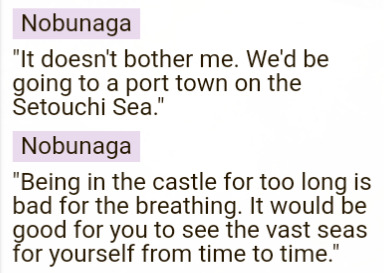
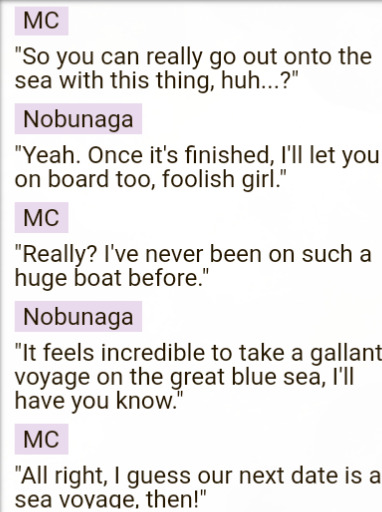
Well, I suppose they needed to go there in order to encounter Kobayakawa, but this actually just makes no sense.
Setōuchi is ridiculously far away from Kiyosu. There's no reason to go that far away just for ships because it's inconvenient, and besides the distance only risks all sorts of problems. Not only that, but Owari Province has sea ports (see map below). It's not land locked. Why do you even need to go elsewhere for the ships?
It would be slightly more sensible if they'd been at Azuchi, because the province of Oumi is indeed land-locked, and closer to Setōuchi. However, MC said Kiyosu, so they're not in Azuchi yet.
As an example, Nobunaga's war ships that was sent to fight the Mouri-Murakami navy in their later fights were historically built in Ise province. Nobunaga was already in Azuchi in real life here, but even if he's still in Kiyosu it'd make more sense for them to just go to Ise to get ships. For plot purposes just say that the shipbuilders there are much more skilled than Owari's local ones.

10 notes
·
View notes
Text
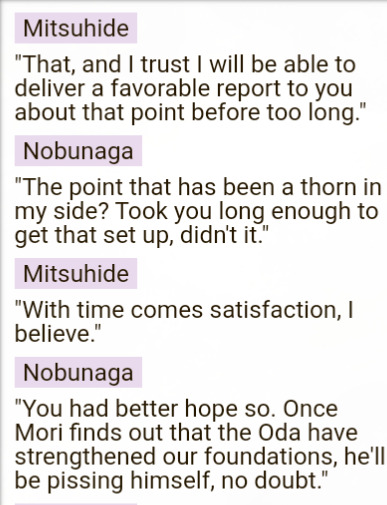
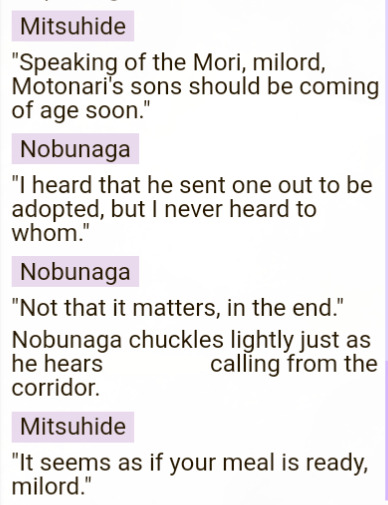
Quick reminder that SLBP drops the "long o" sounds, and "Mori" in other publications may be spelled as "Mouri". This family is completely unrelated to Ranmaru's "Mori" family.
In history Motonari sent a lot of sons out for adoptions. To the point that of his 9 sons, perhaps only 3 of them remained surnamed "Mouri". Even within the context of just SLBP, there's more than one that got adopted out.
I think the part that says "he sent one out" is a mistranslation because even though Japanese has a way to render words plural, it's sometimes not used. This creates ambiguity that requires the translator to pay attention to the original context to know if this is plural or not.
I don't remember if in the actual event it's already specified that Kikkawa Motoharu and Kobayakawa Takakage are brothers or not, but I referenced this in my previous post. Those are two of Motonari's sons, both adopted out, thus having different surnames. Perhaps it wasn't mentioned, and so the translator didn't know.
As always, bending generations is a given in this game (like when the Oda fights Shingen instead of his son), and "Nobunaga is antagonistic against Mouri Motonari" is one of those things that happens when games or other media prioritise starring famous lords over historical facts.
The Oda did eventually fight with the Mouri, but that was after Motonari was a few years dead, and the headship taken over by his successor. In Motonari's life, the Oda and Mouri were allies/cooperating. Nobunaga sent gifts and condolences when Motonari died, and New Year's greetings were regularly sent over to the Mouri.
#samurai love ballad party#slbp#event route#story event#mouri motonari#kobayakawa takakage#kikkawa motoharu
9 notes
·
View notes
Text
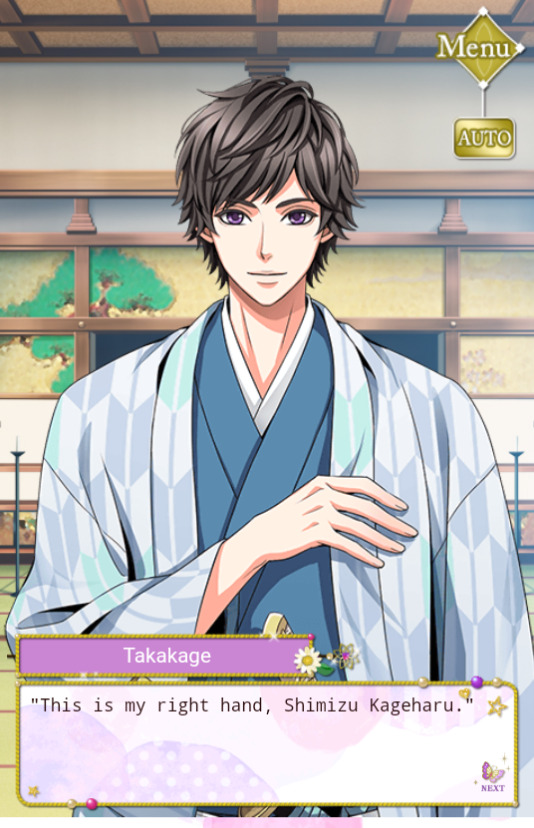

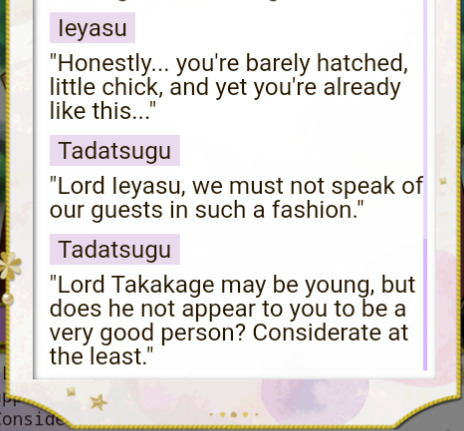
SLBP has been skewing historical ages around as the story needs, which is understandable, because otherwise you'd have people being dead or too old or too young.
When it comes to NPCs, though, I sometimes wonder why characters are made to be the way they are.
Kobayakawa Takakage is in real life older than Nobunaga, and naturally also older than Ieyasu. I'm curious what was the reasoning for making him this young, since I don't see anything about his character in the story that really needed to be this way. Maybe they want his father Mouri Motonari to still be alive in this universe, so they can't have Takakage (and his brother Motoharu) to be too old.
Shimizu Kageharu, on the other hand, was historically the one who is very very young in comparison to the other lords. He's younger than Masamune, even. Why turn him into this gruff old man? Maybe they just pre-emptively designed a tough looking older vassal, and then picked a completely random name from among Kobayakawa Takakage's vassals without caring about the person's historical identity.
#samurai love ballad party#slbp#commentary#story event#event route#kobayakawa takakage#shimizu kageharu
10 notes
·
View notes
Text

This is actually apparently a misconception that many people have that people in the feudal era thinks like this. This is such a late-date legend that hails from around the ending of Edo era, entering the Meiji.
This story event takes it to such extremes that even the citizenry have a fear of it, but the commonly spread legend is actually just the samurai that don't like it. It falls as a whole, like a head that's chopped off. It has the connotation of execution, which samurai supposedly find to be shameful/dishonourable.
The camellia is usually contrasted with sakura, whose scattering petals are considered "beautiful" and graceful, and a more befitting image for a samurai's death.
This narrative really doesn't make any sense in the first place, because even if a samurai commit seppuku honourably, their heads get chopped off too, so what's the difference?
Anyway. Even during the Edo era the samurai loves camellias. Many houses would go out of their way to breed and raise camellias.
The rumour of camellia hate supposedly came about because the people who toppled the shogunate, the clans who hail from Satsuma province and Choushuu domain of Nagato, famously really loved their camellias. The people of Edo (the shogunate capital, now Tokyo), who view those people as traitors or rebels, hated them and regularly complained about them.
Perhaps because the Edoites were connected to the old shogunate, the story of "these people from the bygone era dislike of camellia-loving people" somehow morphed into "samurai don't like the camellias themselves".
22 notes
·
View notes
Text


"Kamishimo" 裃 is the grey part of the outfit the man is wearing, which is a matching set of kataginu (the "sleeveless vest") and hakama.
The term literally means "up and down", and it used to refer to any set of top and bottom with matching fabrics in older time period. However, entering the Edo period, it specifically refers to this "samurai uniform", so to speak. I'm not too clear if this is already an exclusive term during the Sengoku, but never mind that for the story.

"Uchikake" 打掛 is the beautiful outer coat of the woman's outfit, as mentioned in the story. "Short-sleeved" kimono is called kosode 小袖, because the sleeves are shorter than the "standard" wear of the upper class of the older aristocratic eras (uchikake is one of them).
Kosode originally is a "commoner wear", but is eventually adopted as regular wear by the samurai class too. The blue part of what the man wears is also a kosode.
In many ways, "kosode" is essentially the equivalent of "standard kimono" that people usually know of today. Some websites say that modern kimono is longer than "kosode", as in the kosode maybe reaches only around mid-calf, while the modern kimono goes down to the ankles.

41 notes
·
View notes
Text

I tried looking up if this is a real clan or not, but I cannot find this family. Maybe it's just a very obscure clan that I need to actually know the exact kanji to find, but I was only able to find a person named Nakasato Hanshirou who was lord of Nakasato Castle around the northern tip of Oushuu.
It's quite far away from the Date domains, as Oushuu is itself a very large province. It's about... maybe 20 times the size of Owari and Mikawa, and maybe at least 10 times Kai. So someone that far away maybe equal to the distance from Masamune's place to Osaka?
Sometimes the game would make up nonsense surnames or clans for fluff/non-historical events, so this might just be a coincidence and does not refer to reality.
15 notes
·
View notes
Note
Hi, May I ask if there is any links for previous events exclusive photos?? Especially for yukimura. Thank you
Sharing of CG/illustrations is forbidden by Voltage rules, many blogs that used to share these pictures have taken them all down. I don't know where to find them unless you maybe try searching it on Google. I recommend reaching out privately/through DMs to other players.
3 notes
·
View notes
Photo
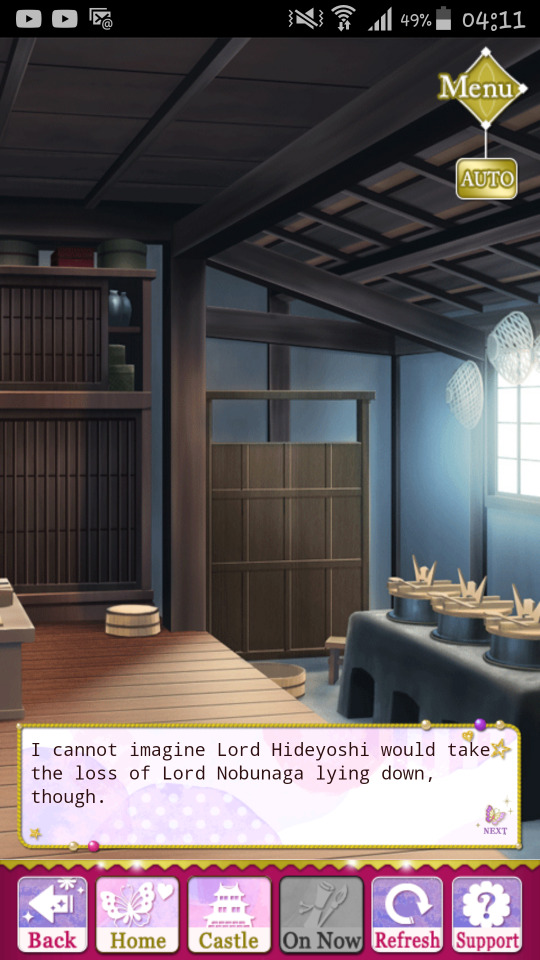
I'm quite sure this is a reference to Hideyoshi giving Mitsuhide a warning in Act 1. It could be incidental, but since she specifically said Hideyoshi and not the others, I think it might be purposeful.
Unfortunately, when I first read the Act 1, the translation was in error and what Hideyoshi says is completely different in English. I haven’t replayed the Act 1 again to see if the translation has been changed since (hopefully it has), but I don’t have the screenshots of that scene anyway, so I will just provide the context here with quotes from the Japanese text.
In the final or epilogue chapter of Mitsuhide’s Act 1, after they dealt with Nagamasa’s betrayal, Hideyoshi dropped by and said this:
[自分は下賤の出から取りたててもらった恩があるから、信長様を裏切るようなら]
I’m indebted (to Nobunaga) because I’ve been raised (in rank) from my humble origins, so if anyone betrays Nobunaga-sama…
[光秀さんでも容赦しませんよ]
… I will not forgive them, even if it’s you, Mitsuhide-san.
Not history-related, just a call back to the previous route
12 notes
·
View notes
Photo
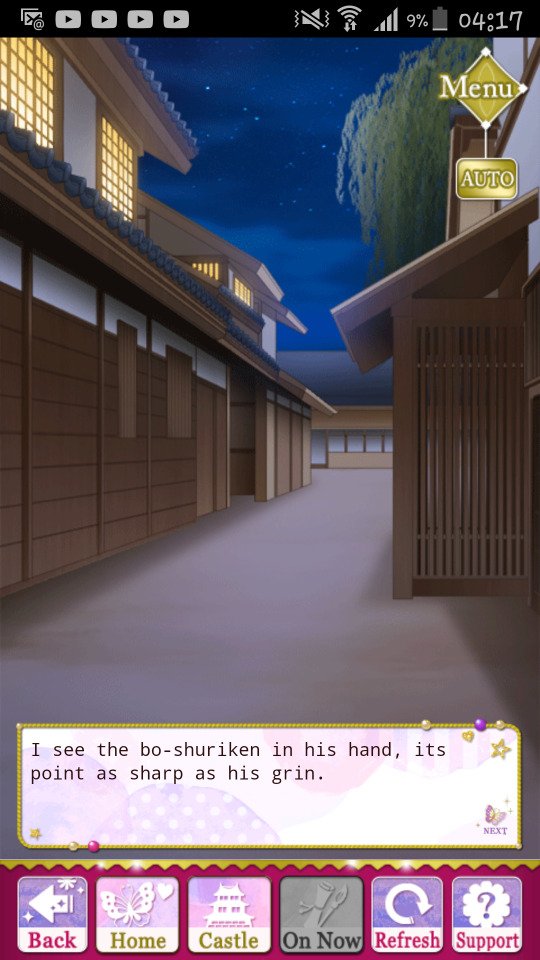

Bo-shuriken are stick-shaped shuriken. There’s some variations, but a lot of it looks a little bit like a pencil.
This is slightly thicker than the hari-shuriken, the needles that Hanzo uses, and typically on the short side (to be hidden in the palm).
29 notes
·
View notes
Note
Hello, I’m trying to look more into civil administration in Sengoku Japan, and also other things that daimyo would deal with such as how natural disasters affected their community, dealing with famine, taxation, etc. could you point me in the right direction?
As it happens, William Wayne Farris had 2 books that discussed the citizenry. "Japan's Medieval Population: Famine, Fertility, And Warfare in a Transformative Age" has some discussions on things like taxes or famine. I don't know if that book actually discussed what the rulers do when disaster hits, though, or if it only documents instances of disaster through history.
I have only seen a couple of pages of preview, I haven't been able to get the full book yet.
In general, if you're trying to look for facts, make sure to search for books that specifies "pre-Tokugawa" or "pre 1600". The Edo policies retain a lot of the basics that was only implemented by Hideyoshi after unification, so a lot of it doesn't apply to the time when the land is not yet unified.
6 notes
·
View notes
Note
Hi there, I have a few questions about names, specifically in a sense of disrespect. For Toshiie, MC seems to call him "Inuchiyo" because it's his childhood name and that's how they grew up. So why is it okay for Hideyoshi to call him Inuchiyo if he didn't know him during childhood? Would that be disrespectful? And for Shingen, Kansuke calls him "Harunobu", which I think is his name pre-priesthood, while everyone calls him Shingen. Is that him being unique or is that respectful/disrespectful?
These are explained in their main routes. Well, the Inuchiyo one is. I don't remember if they explained the Harunobu one in the main route or in an event.
Before, Hideyoshi just calls Toshiie "puppy" all the time, and not even with a name. But eventually he made friends with Toshiie proper, and wanted to call him Toshiie, but Toshiie said to just use Inuchiyo because "Toshiie" is too formal.
In this game Shingen is not a priest, but yes, he did change his name from Harunobu to Shingen at some point. Kansuke still calling Shingen "Harunobu" is just to show that they've been friends since before Shingen changed his name.
I'm assuming you're not asking about historical accuracy here, because none of these has anything to do with history. It's just anime/otome game cutesy plot logic.
7 notes
·
View notes
Photo
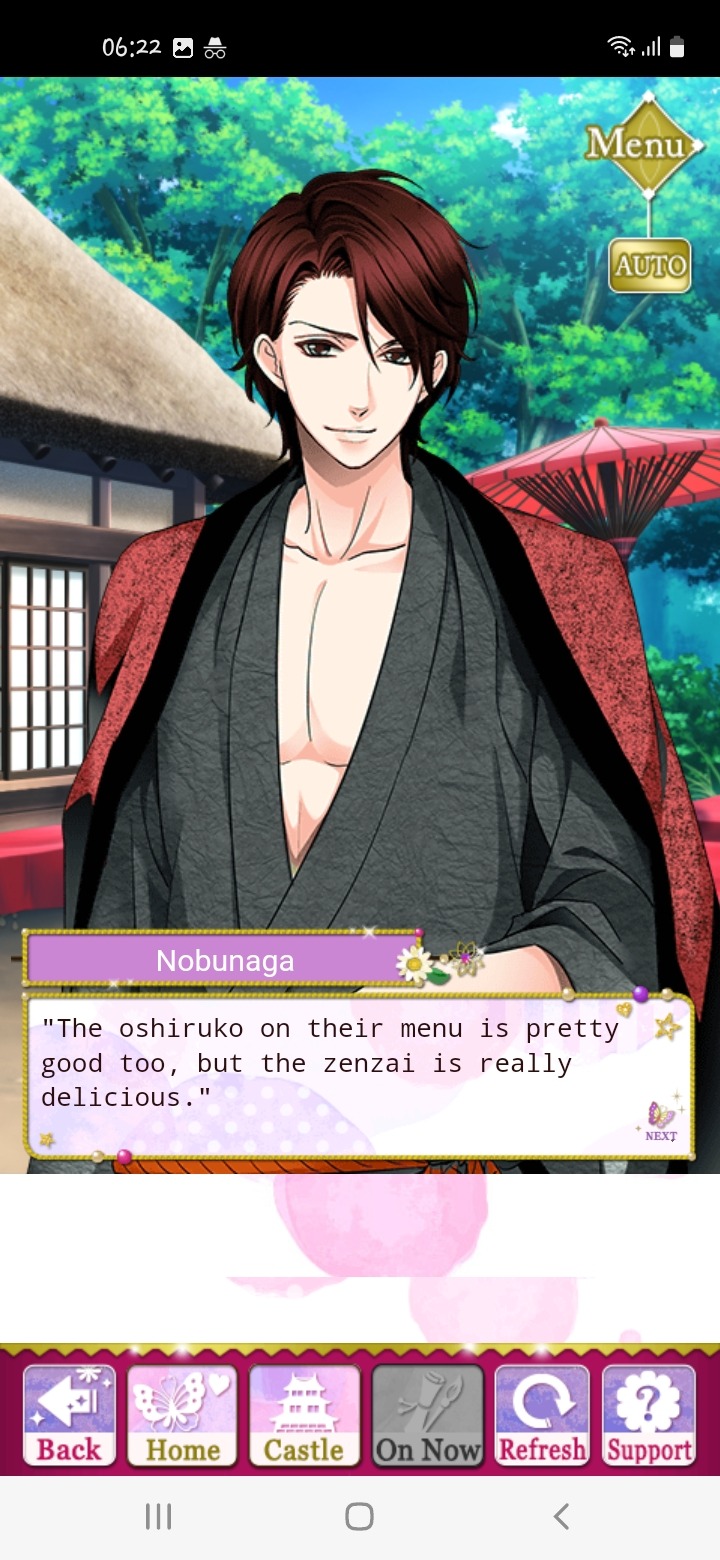

The difference between zenzai and oshiruko differs depending on where you’re form. I’m assuming that they’re talking in the Kanto style lingo here, because Kojuro’s oshiruko in the game is the coarse bean soup and in Kansai terms that would’ve been a “zenzai”.
“Smooth” bean soup means that you can’t see the beans, and it really just looks more like a red liquid.
Regionally-speaking Nobunaga’s territories are closer to Kansai (it has its own region designation, not Kanto and not Kansai), but well, Voltage staff seems to be usually Tokyoites (Kanto).
Table of difference below:
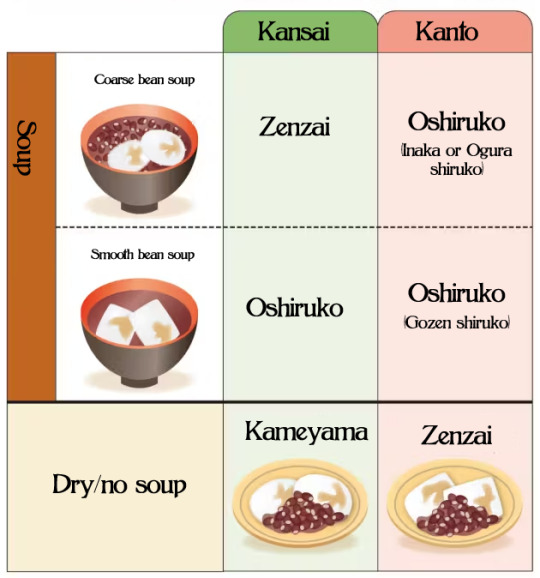
27 notes
·
View notes
Photo
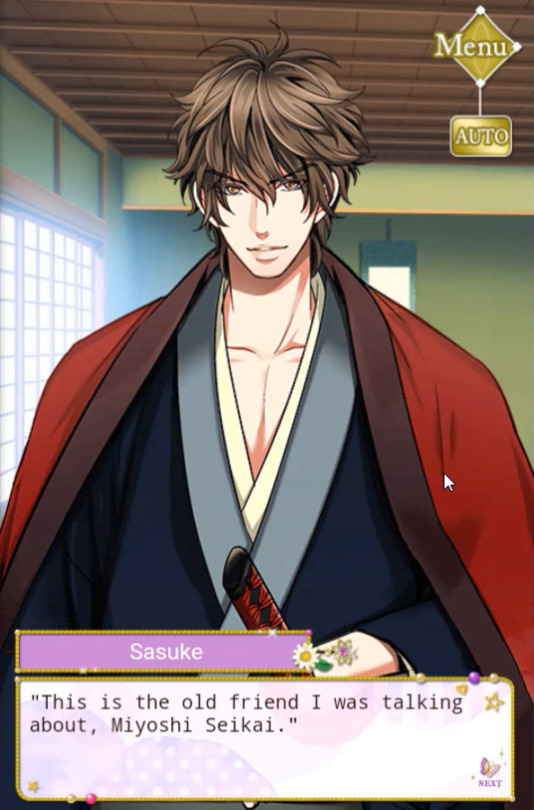
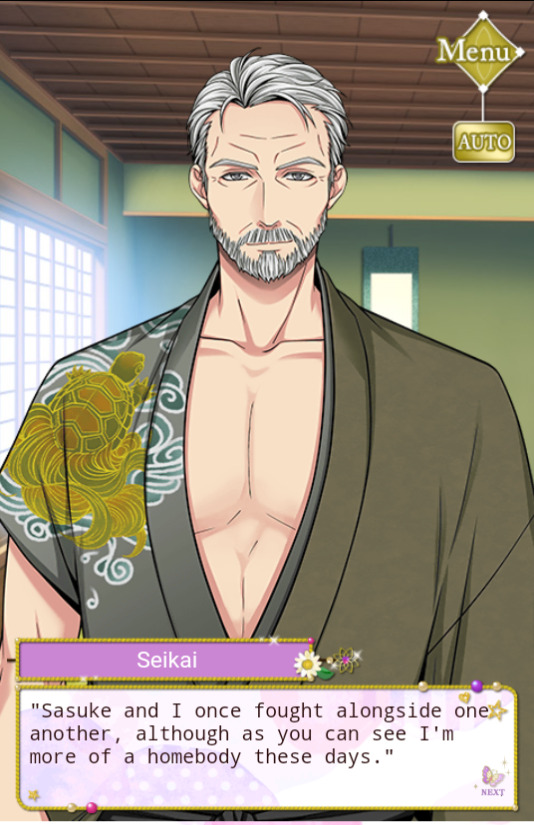
And another one of the Sanada Ten joins us. I’ve referenced this before, but the full gang was meant to unite in Sasuke’s sequel, though we don’t know when that will ever show up in SLBP.
Miyoshi Seikai’s full name in the original legends was Miyoshi Seikai-Nyuudou 三好清海入道. “Nyuudou” refers to “entering the path of Buddhism”, and this can refer to both an actual monk, or lay-monks (people who are devoted to Buddhism, but still live regular lives and don’t actually become monks). As such his standard depiction was something more like a warrior-monk type.
The game dropped the Nyuudou part, and so he’s just a regular warrior now.
19 notes
·
View notes
Photo
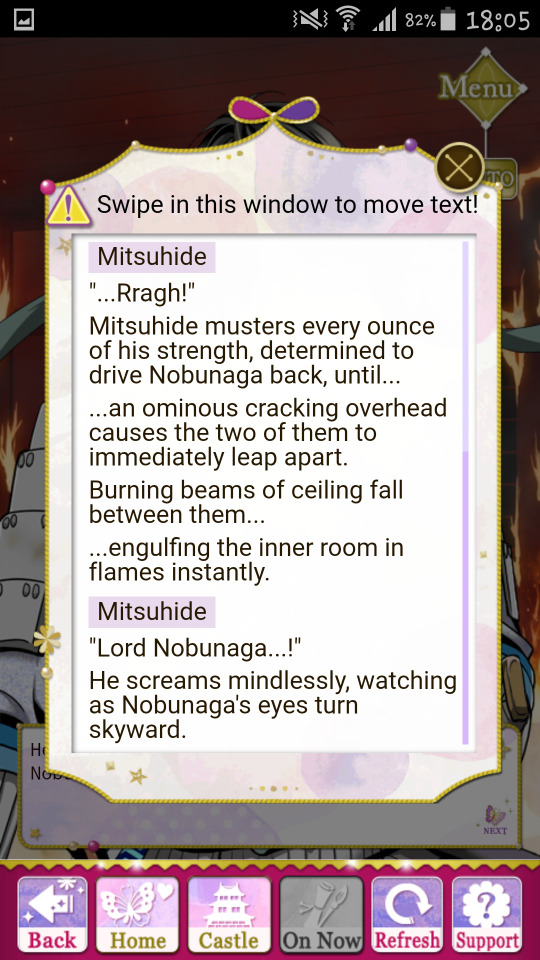
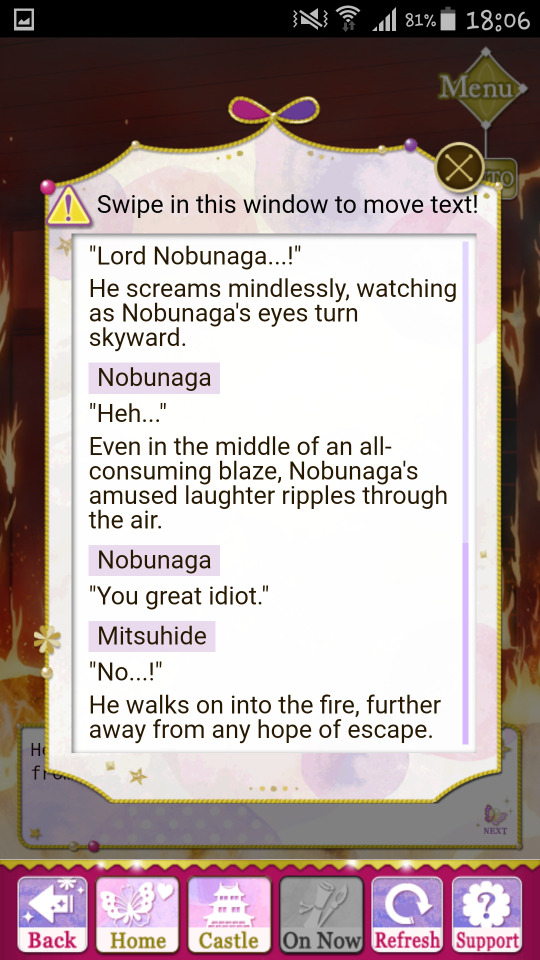


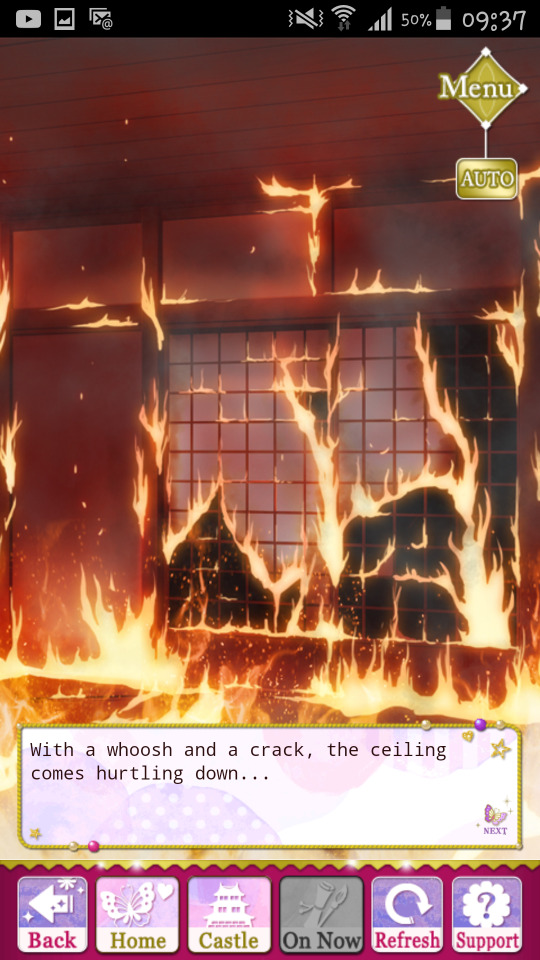

In terms of the story, this is why I said in my previous post the narration sounds like it was intended to mean that Nobunaga is dead.
However, the part that says “he walks further into the fire” technically only means he just went deeper in to the temple (away from the door Mitsuhide came in from). Based on how Japanese architecture works, as long as the fire doesn’t block off all the outer walls of the temple, I personally think there is still a possibility for escape. Perhaps the crumbling rubble only obstructed Nobunaga from Hideyoshi and Mitsuhide’s view, and he just headed towards a different part of the temple and escaped from that other side.
Conspiracies aside, let’s talk about the fire itself.
The Shinchoukouki document described that Nobunaga set the place on fire, and some interpreted that it’s precisely so that his body would be destroyed and that Mitsuhide would not be able to desecrate it.
It’s a common practice for samurai to cut off the enemy’s head and put them on display as a mark of their achievement. Lords and commanders who dread this fate might request their vassals to bury or hide their bodies after they commit seppuku.
Shinchoukouki also described that Nobunaga’s heir had requested exactly that of his vassals. After he committed seppuku, his remains was immediately buried in the mansion he was holding fort at, and was also never found.
There’s a lot of novels, movies, and dramas where Nobunaga specifically asked Ranmaru to light the fire, but I think it’s just drama flavouring (in line with the popular trope that Ranmaru was Nobunaga’s personal assistant of sorts). I don’t know if such a thing was ever explicitly documented in any historical account.
There is another record, purportedly a written transcription of the narration of one of the Akechi soldiers, that said that fire broke out from the kitchens. This implies a completely accidental fire.
13 notes
·
View notes
Photo

I’m not sure if the game intended this to be a mystery or not. In the actual Honnouji scene, the narration and Hideyoshi and Mitsuhide’s reaction strongly implies that Nobunaga really was dead, even though it didn’t explicitly show that he dropped dead.
Still, "Nobunaga’s corpse was never found” was a saying that’s bandied about a lot online, leading to conspiracy theories about how he might have escaped or if someone secretly removed his body.
However, some experts claim that the corpse is not missing. It’s just “unidentifiable”. There are so many dead in Honnouji, and not to mention that the building burned down. It’s only logical to assume that nobody could identify which among the piles of dead bodies was supposed to be Nobunaga. Even in modern day, with all its high-end forensic technology, it’s still not easy to identify burnt corpses.
The account by Luis Frois also assumed as such, and he said that Nobunaga’s remains was burnt up and nothing of him is left. He wasn’t there in the Honnouji premises to actually poke around the ashes, but he was in the church in Kyoto, which was close enough for him to have witnessed the fire.
I think there is the flimsiest chance that Nobunaga could really have just pretended to be dead, and then ran off into the sunset to live the rest of his life in peace. With so many people running around in Honnouji that night, who’s to say that he did not mingle with the escaping servants, and slip out? If you really want to play conspiracy games, might as well just say he’s not dead and just vanished.
There’s no reason to conspire overly-complicated explanations about how he did die, but the body had been taken or some such, though. Fire just burn things up, and without technology, burnt bodies are just simply unidentifiable.
#tw corpse#cw corpse#slbp#samurai love ballad party#akechi route#SEQUEL ROUTE#commentary#ODA NOBUNAGA
14 notes
·
View notes
Note
Hello, I was wondering if there was a way samurai in battle avoided arrows. I know there were other soldiers in history who used shields to block oncoming arrows, but did the samurai do the same thing?
Samurai did too have shields.
The short answer for the reason why in the Sengoku shields are rarely used is because bows and arrows are no longer the preferred weaponry in the field. People tend to use guns and spears more often. Shields are no use against such weapons, so personal hand-shields are no longer used.
Another aspect to this is that the samurai armour IS the shield. The large shoulder plates are not fixed on the arm, it can be swung around to be used as a shield, as shown below:

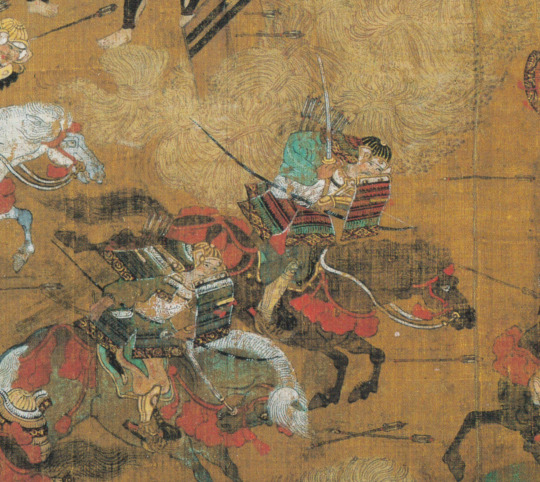
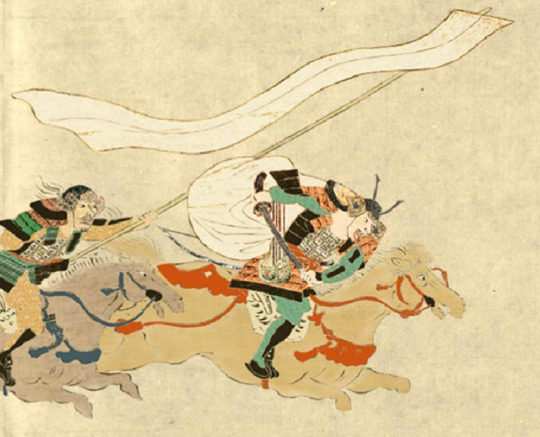
For the foot soldiers who might not be outfitted with this kind of armour, unfortunately yes, they are more exposed to the arrows.
There are still, however, the "standing shields" propped on the ground that are still seen in paintings of Sengoku battles, so we assume that those are still in use. While standing still, the soldiers can hide behind these shields. However, if on the move, yes, they're also exposed to arrows.

There's also supposedly very small hand-held shields called kotate 小楯 that are still in use and/or existing in the Sengoku, but without pictures I'm not sure what that is like. Supposedly this word can refer to anything that is used as a shield, so it might not even be a specifically designed shield, but any random things from broken doors to even (pardon the morbidity of this) your dead comrades' corpses.
Someone conveniently already compiled a post of usage of shields in paintings and records in Japanese history, so I'd just link you to that post rather than re-type everything here:
9 notes
·
View notes